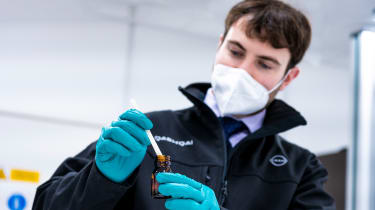New car smell: what is it and how do brands make it?
There’s more to making a new car smell nice than simply spraying perfume. We meet Nissan’s expert in odour evaluation
Everyone wants their car to have styling that looks good, high-quality materials that feel good and – in some cases – an exhaust note that sounds good. What you rarely hear drivers talk about, though, is how their cars smell – or, rather, how they don’t.
This is actually quite unfair, because manufacturers put a lot of work into ensuring that the combinations of materials they use when building a new car don’t create any unpleasant odours. We visited the Nissan Technical Centre Europe (NTCE) in Cranfield, Bedfordshire, to sniff out the secrets behind this highly scientific endeavour.
Upon arrival, we were introduced to Peter Eastland – odour evaluation lead engineer at NTCE – who was concerned when we mentioned having stopped for a coffee on the way in, because caffeine, along with nicotine, can damage your sense of smell.
“Smoking, for example, damages the nerves at the base of your skull,” Eastland explained. “They link up to the olfactory bulb – that’s the bit that connects your smelling ability to your brain. Once those cells get damaged, they can’t replicate themselves, and you lose your sense of smell.”
Fortunately, we don’t smoke and only had one coffee that morning, so Eastland assured us that our sense of smell should be up to the task, as he presented us with our first scent sample. It didn’t have a strong smell, but what we did pick up seemed quite natural. Our best guess was that it was from tree sap or something similar, but the correct answer was in fact soil. The purpose of this exercise was to go through the same nose training that Eastland and his team goes through in preparation for ensuring each new Nissan model doesn’t smell unpleasant.
Eastland is especially suited to his role thanks to his naturally keen sense of smell, while a master’s degree in chemistry with forensic science doesn’t hurt, either. He’s been with Nissan since 2016, but the manufacturer’s mission to keep its cars smelling good has been going since the nineties. It’s a global mission, too. Eastland is Nissan’s smell expert in Europe, but he has counterparts in both Japan and the US.
Our guess with the second scent sample was closer – we said that it smelled sweet and artificial, and it turned out to be derived from candy floss. Our confidence was quickly shattered, though, when we guessed the third sample as being the scent of a pine tree. This was only half-right – it was actually a mix of vanilla and pine extract, and we had only picked up on one of the two ingredients.
“This is an example of how, when you have different molecules, they have different volatilities,” Eastland explained. “Some you can pick up instantly, while others linger in the background.
“One of the techniques I recommend is not to analyse the scent when it’s entering your nostrils, but rather when you’re exhaling it. At the top of your nose, you have nerve endings connected to the olfactory bulb.
“When air comes into your nose, it doesn’t come all the way to the top of the nerves, but it does hit them when you breathe out sharply. That’s why when a dog is sniffing something, it will breathe in gently, then breathe out really fast.”
Another factor Eastland taught us to consider was temperature. Some elements of a car’s interior may be inoffensive in cold weather, but they can start to smell bad on a hot day. To demonstrate this, we compared the scent of a room-temperature piece of velcro to one that had been heated up in a massive oven, and the difference was definitely noticeable.
Despite all this effort, Nissan sadly isn’t working on developing its own brand of new car smell. Instead, Eastland and his team are focused on eliminating any nasty odours from Nissan’s new models before they go to market. With so many different plastics, fabrics and finishes at play, it’s vital the heady cocktail of that ‘new car smell’ doesn’t combine to create a stink with buyers, or with subsequent owners further down the track.
Our fragrant favourites
If your car’s interior has developed any unpleasant odours, one solution is a car air freshener. Among the best-known is Little Trees, which were invented in 1952 by a German-Jewish scientist who had fled to New York during the Second World War.
Today, there are a huge range of different car air fresheners on the market. In our last group test, we reckoned Lynx Car Freshener Black was the best, followed by Little Trees Invisi Sport and Sensi-Qui Parfum & Gel New Car. These winners were chosen for a combination of having a pleasant aroma – as judged by a panel – and for being easy to fit to a car without causing damage.
Click here for our complete guide to buying a new car...
Find a car with the experts







